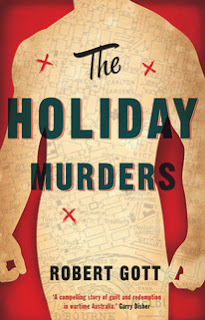I have always considered this my favorite mystery by Dorothy L. Sayers, so I was glad to find that the story lived up to my memories of it. Some of Sayers' books were a disappointment to me on a second read.
I like mysteries with an office setting, especially older mysteries like this one. I have enjoyed at least two others: Minute for Murder (1947) by Nicholas Blake, set in the Visual Propaganda Division in the Ministry of Morale, and Smallbone Deceased (1950) by Michael Gilbert, set in the law firm of Horniman, Birley and Craine. This one is mainly set in the offices of Pym's Publicity.
 The author does have a lot to say, via her characters, about the evils of advertising. Per her obituary in the New York Times, Sayers' "first job was that of copy writer in a leading London advertising agency." And that was the main attraction of this book for me.
The author does have a lot to say, via her characters, about the evils of advertising. Per her obituary in the New York Times, Sayers' "first job was that of copy writer in a leading London advertising agency." And that was the main attraction of this book for me.In a recent review, I commented on my dislike of stories about detectives working undercover, but in this case the undercover plot was fun. Wimsey could have been in some danger when consorting with drug dealers, but this was more an adventure story than a thriller. It surprised me that a novel set in the early 1930s has a good deal of the plot related to drug dealing. Somehow I always see this as a more recent problem.
I did especially like that the story allowed Peter to spend time with his sister Mary and her husband Chief Inspector Parker, a pair that I have always enjoyed. And as a ploy to maintain his cover, Peter also drops in on a party given by his older brother Gerald, the Duke of Denver, and irritates Gerald's snobbish wife, Helen.
I thought this book was well written and a good puzzle, although the puzzle element of a mystery is not the most important part to me. Possibly a bit too long. Some readers complain about the lengthy discussions of public schools vs state education and cricket, yet I did not think these departures went on too long to be interesting. And, at least in the case of the chapter on the cricket game, it does relate to the plot. Even though this was a reread, I was still surprised at the ending and the way it was handled.
See other views at:
Clothes in Books
crossexaminingcrime
The View from the Blue House
A Crime is Afoot
Reactions to Reading
Simon's Book Blog
-----------------------------
Publisher: Perennial Library, 1986. Orig. pub. 1933.
Length: 323 pages
Format: Paperback
Series: Peter Wimsey, #8
Setting: UK
Genre: Mystery
Source: I purchased my copies.


















